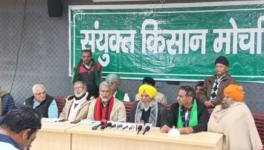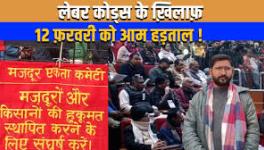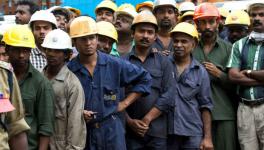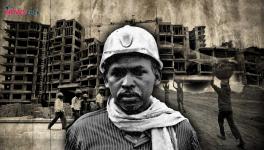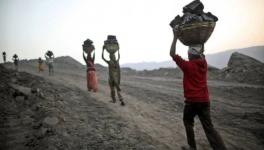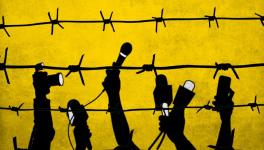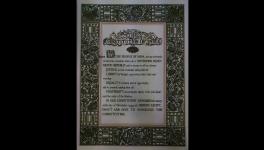Whose Media Freedom? Whose Media Order?
As hundreds of journalists and co press-workers are on the roads, with half the news offices virtually shut, many journalists working from home, and amid an atmosphere of increasing attacks on the media in India, comes the World Press Freedom Report 2022 – indeed a shocker on Indian press freedom today. India’s ranking in the index fell from 142 in 2021 to 150 this year, out of 180 countries. In 2016, India had been ranked 133.
The steady deterioration in media freedom under the Narendra Modi government is recorded by this index. It speaks of “worsened conditions” for reporters and news organisations . The index adds that media in India, among nations reputed to be more democratic, faces pressure from “increasingly authoritarian and /or nationalist governments.”
In fact, the reality is grimmer. Consider the fact that we are in an ‘undeclared Emergency’ that’s been increasing since 2016. The horrific declared Emergency of 1975 with its tremors on press freedom had lasted only 21months. Intimidation of the media by the State is today a marked feature. False cases are being filed against journalists and editors, especially in Bharatiya Janata Party- ruled states. Some journalists are facing sedition cases for writing reports that are not to the liking of the powers that be.
A draconian law like the Unlawful Activities Prevention Act (UAPA) is being used against journalists, as in the case of Fahad Shah in Srinagar and Siddique Kappan in Uttar Pradesh – both of whom are still in jail under preventive detention.
Certain other clear pointers to the growing attacks and intimidation of media are:
1. Physical attacks on media personnel by communal extremist gangs have taken place, especially in BJP-ruled states.
2. The government’s efforts to browbeat the media have taken the form of targeting recalcitrant media houses with economic offences. The Income Tax department, Enforcement Directorate and other agencies are often being blatantly used to harass and prosecute the management of such media houses.
3. Efforts to extend government control and censorship extend to all types of media. Given the proliferation of digital news platforms, new rules under the Information Technology Act were introduced in 2021 that allow the Ministry of Information & Broadcasting to dictate content to digital news media platforms and giving the government the right to delete digital news content considered objectionable. There are also efforts to muzzle the media by imposing bans on news channels either for a limited period of time or on a permanent basis.
There are ominous signs of how the independence and integrity of the media are being compromised by the change in nature of the ownership of the media owned and controlled by corporate and big business houses. This is more evident in the electronic media which, with a few exceptions, is being co-opted by the Modi government to act as drumbeaters for the current regime. Worse, some of these have begun to aggressively peddle the Hindutva communal propaganda, pointing clearly to a corporate-Hindutva nexus, which is more visible in the Hindi media as also in sections of the Urdu press. Overall, democracy is being reduced to a mockery. Sycophancy and blatant communal propaganda have become the order of the day.
Further, journalists and media organisations that seek to conduct fair and objective reporting and maintain editorial independence, are facing “heavy odds with the might of the State ranged against them,” says the report. Remember the 1975 Emergency and veteran BJP leader L K Advani’s comment on the media? “They were asked to bend and they began to crawl”, he had said. Things are worsening now.
The press freedom report points out that an average of three or four journalists are being killed in connection with their work every year (one killed since January 2022 and 13 currently in prison). India, according to the report, is one of the world’s “most dangerous countries for media persons.”
This, however, is only part of the story. Questions are also being raised and replies evaded about the use Israeli spyware Pegasus to keep a tab on journalists, artistes, writers, social workers, politicians etc.
Other danger pointers are that right in the capital of India, the approval process of Central press accreditation has been made tough, along with other curbs, leading to reduced coverage of Parliament issues. Even the once prestigious Long and Distinguished Category of journalists has been changed and made into a selective farce. In the accreditation committees both at the Centre and the Delhi state, most bodies once recognised now see signs of government selectivity.
Urdu Press
It’s 200 years of the Urdu press and it indeed played a huge role in the freedom struggle but today due to advertisement squeeze and some other changes, they are gasping for survival. Many have sold out.
There was a time when people spoke of a viable Urdu news service under United News of India (UNI) umbrella taking off. Today, even UNI is being systematically killed with salary cuts, pending wages and former journalists who have left or compelled to leave await compensation. The Press Trust of India (PTI) is now under heavy government pressure from time to time, while some private news and TV agencies are enjoying government patronage. Rashtriya Swayamsevak Sangh’s Hindustan Samachar has also had a facelift and there is common talk about government patronage for Asian News International ANI.
There are ominous signs pointing to the graver dangers of communalisation of news. As has been pointed out in The Wire, Indira Gandhi’s national emergency, which lasted 21 months, saw censorship, the abolition of the Press Council of India and the arrest of journalists, but Narendra Modi has criminalised journalism on a scale not seen since 1977, rendered the (now largely toothless) Press Council irrelevant using administrative means and revived the spirit of the obnoxious ‘Prevention of Publication of Objectionable Matter Act, 1976’. Via the promulgation of the IT Rules, 2021, through which the government has arrogated the right to delete digital news content that it considers objectionable, Modi’s ‘undeclared emergency’ is already in its eighth year.
Another dangerous trend is the journalists and co-workers freedom to associate with unions of their choice. The new labour codes passed hastily in Parliament marked the beginning of the end of any wage fixation machinery for the news industry as well and, in fact, many managements in anticipation have seen to it that the last Majithia Award remains a mockery with cases pending in court in some cases for almost 10 years. COVID has provided a further excuse for mass retrenchment etc. In fact, the labour codes not only impact labour in the country at large but also the Working Journalists Act, the wage boards and service rules won after years of struggle. The registration of new trade unions will also become more difficult.
According to J S Majumdar, vice president of Centre of Indian Trade Unions (CITU), “the BJP government had three principal neo-liberal aims: firstly, the corporatisation of agriculture through the introduction of the three farm laws; secondly, the destruction of existing labour laws through the introduction of the four Labour Codes; and thirdly the privatisation of government assets including the public sector companies.”
At a recent May Day event, the CITU leader pointed out how in one week, in September 2020, Parliament passed the three farm laws and the four labour codes. The Modi government was defeated in its first aim by a platform of farm unions and had to withdraw the farm laws because of a prolonged and determined campaign against them. The movement of the peasantry, he said, had the support of unions from the public sector.
The government managed to have the labour laws repealed and the labour codes enacted but so far has not been able to implement them in the face of resistance from the working class.
Journalists will be denied many rights, Majumdar said, as the Working Journalists Acts have been repealed through the Social Security Code. These were pioneering labour legislations were enacted during the Nehru era. Now, because the Codes make a distinction between employees and workers, journalists will be denied rights under the labour laws that are still in existence. This needs to be fought, he said.
What is needed, therefore, is more and more unity and the widest possible national alliance of journalists on common issues. Along with this, we need a more autonomous Media Commission, consisting of experts from judiciary, public and Parliament, to replace the Press Council we need a Media Council covering the entire media, including TV networks and other new media platforms, not a government dominated body.
Flashback
In 1956, the Lok Sabha passed the Parliamentary Proceedings (Protection of Publication) Act that protected the media or any persons from prosecution for printing, broadcasting or publishing true reports of the proceedings of either House of Parliament. The brainchild of this Act was none other than Feroze Gandhi, a freedom fighter, Congress party leader. On March 23, 1956 introducing the Nill he said“For the success of our parliamentary form of government and democracy and so that the will of the people shall prevail, it is necessary that our people should know what transpires in this House. This is not your House or my House, it is the House of the people. It is on their behalf that we speak or function in this chamber. These people have a right to know what their chosen representatives say and do. Anything that stands in the way must be removed.”
Gandhi was disappointed that the press had not mentioned names of people complicit in an insurance scam that was discussed in the Rajya Sabha. He challenged the press to print the names but also began to work toward ensuring that the press had protection against any legal obstacles that would hinder them in doing so. But those were different times. Today even the Central Hall is a ‘no go’ area for the press and Parliament coverage stands curtailed.
Right in the Capital of India, a seminar and discussion where Kashmir journalists’ problems were to be discussed along with a reception for them, was postponed indefinitely three to four years ago, under some pressure.
In sum what is required is a two-fold battle, one to save freedom of the press and the second to save freedom of association and to form unions to carry on fight to have a proper time-bound permanent wage fixation machinery, with a Media Council to look into ethical issues and Media Commission of experts and all stakeholders to look into conditions of the wide spectrum of media today.
The writer is a senior journalist and president of Delhi Union of Journalists. The views are personal.
Get the latest reports & analysis with people's perspective on Protests, movements & deep analytical videos, discussions of the current affairs in your Telegram app. Subscribe to NewsClick's Telegram channel & get Real-Time updates on stories, as they get published on our website.









